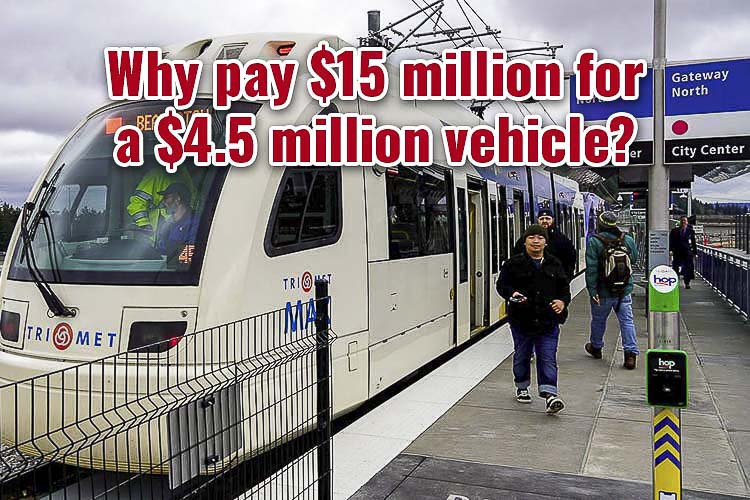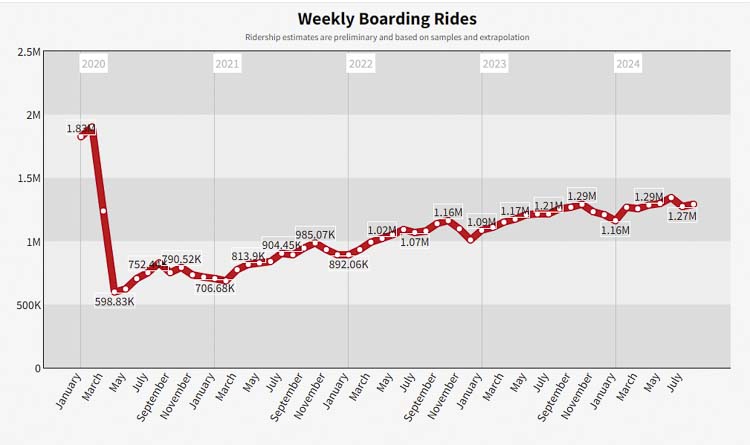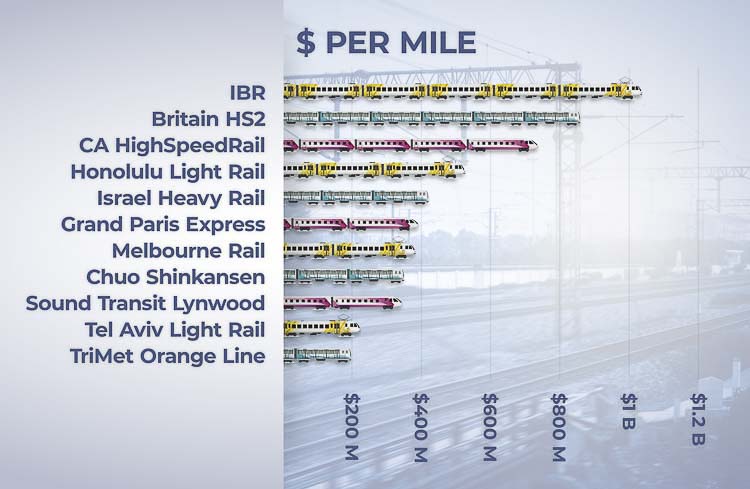Nineteen light rail vehicles at triple the price not a concern for IBR team
John Ley
For Clark County Today
The Interstate Bridge Replacement Program (IBR) defends TriMet’s demands for 19 new light rail vehicles as part of the $2 billion, 1.9-mile MAX light rail extension into Vancouver. Furthermore, IBR officials defend TriMet seeking triple the cost of each of those vehicles.
Add to this the fact that on a “per mile” basis, this project is the world’s most expensive rail project at just over $1 billion per mile. Furthermore, the cost of the entire project has exploded in the past four years.
IBR officials said they could build the project for $3.2 – $4.8 billion in 2020. It jumped to a range of $5 – $7.5 billion two years later. A year ago Program Administrator Greg Johnson told the community costs will increase again, but he won’t tell citizens until the summer of 2025, after the DSEIS has been submitted.
These should be red flags to both citizens and federal officials overseeing the project.

Buried in the 10,000-plus pages of the Draft Supplemental Environmental Impact Statement (DSEIS) released by the IBR, are many details related to the light rail extension into Vancouver. The program recommends the project include “high capacity” transit, and chose the TriMet light rail over Bus Rapid Transit (BRT). C-TRAN has built three BRT lines for about $50 million each in the last decade.
TriMet’s Board of Directors is demanding $21.6 million in new taxes from both Oregon and Washington in order to pay for the operations and maintenance of the 1.9 mile extension of the Yellow Line. They are demanding 19 new light rail vehicles, or 10 vehicles per mile, a seemingly ridiculous number considering two-car trains only run four times an hour during peak periods and every 30 minutes at other times of the day.
Additionally, TriMet is asking the program to pay between $190 million and $290 million for the light rail vehicles, or $10 – $15 million per vehicle. TriMet recently paid just $4.5 million for four new vehicles as part of their 10 mile “Better Red” light rail extension from Beaverton to Hillsboro. On top of that, Trimet officials are asking for the program to expand their Gresham maintenance facility.
The Federal Transit Administration (FTA) rules only allow federal funding to cover half the capital cost of a new mass transit project. That means Oregon and Washington taxpayers should each pick up one quarter of the remaining capital cost, or $500 million each.
Southwest Washington citizens should recall that C-TRAN offers the only transit service across the Columbia River. Oregon has never paid for the capital cost of new buses, nor anything towards the operations and maintenance of the C-TRAN buses that cross the Columbia River on both the I-5 and I-205 bridges.
Light rail a chronic under-performer
“Light rail has been a chronic under-performer in Portland for 38 years, and it always will be,” stated John Charles of the Cascade Policy Institute (CPI). “But results never seem to matter for TriMet.”
The CPI has documented a long history of broken promises by TriMet regarding its MAX light rail service. In 2019, multiple failures to deliver were reported, including eight departures an hour on the Yellow Line by 2020. The report included a brief history of the Yellow Line.
The Yellow Line originated in 1988 as a 21-mile project connecting Vancouver, Washington with Downtown Portland and Clackamas Town Center. This plan was scrapped after Clark County voters defeated a proposal to raise $236.5 million in 1995 and Oregon voters turned down a $475 million regional ballot measure in 1998.
“At no point since the Yellow Line opened has ridership met projected levels,” the CPI reports. By 2020 the line’s ridership was expected to have 18,100 average weekday riders. In April 2019 ridership only reached 13,270. In August, 2024, Yellow Line ridership was 10,530, 42 percent below promised 2020 levels.

In the DSEIS published in September by the IBR, they indicate TriMet will provide service every 7.5 minutes, or eight departures an hour. That was the same promise made in the failed Columbia River Crossing (CRC) a decade ago. Recall that an Oregon Supreme Court Justice labeled the CRC “a light rail project in search of a bridge.”
In a June 2013 letter to the FTA, Charles said “TriMet service is in a death spiral.”
TriMet General Manager told his board in February that the forecast for TriMet service shows that by 2030, the agency will have a “revenue-expenditure imbalance” of some $200 million. Therefore, TriMet clearly does not expect to meet its light rail service obligations to FTA at any time during the life of the two relevant FFGAs.
In your response to me on June 20, 2011, you noted that many transit agencies experience temporary service declines due to various economic factors. Such conditions were “not typically viewed by FTA as a breach of contract.” You pointed out that Section 19(a) of the FTA FFGA discusses “default” in terms of “…substantial failure of the Grantee to complete the Project in accordance with the Application” for federal funding.
It is clear that TriMet has failed and will continue to fail to meet its contractual obligations to operate federally-financed light rail lines as promised.
Over a decade later, TriMet’s service levels on the Yellow Line remain less than half of promised in terms of per hour departures. Furthermore, ridership is about 42 percent below promised levels.
Two years ago, the CPI noted: “just before the pandemic hit, Yellow Line ridership was more than 25 percent lower than where it was projected to be for 2020. Following the COVID-19 drop-off in ridership, TriMet now doesn’t expect transit ridership to hit pre-pandemic levels until sometime after 2045.”
TriMet broke similar promises on its Green Line service. Ridership has continued to decrease to just over 16,000 average daily riders in August 2019, and is 12,810 today. This is well short of the FEIS’s predicted ridership levels for 2025. With just one year to go, it seems unlikely that the Green Line will attract the additional 33,690 riders needed to hit TriMet’s promised level of 46,500 boarding rides.
All of this information is publicly available and easily accessible for IBR staff.

Clark County Today reached out to the IBR staff and asked if 19 new light rail vehicles for a 1.9-mile extension was reasonable. CCT also asked what cost control measures the IBR had to protect taxpayers.
These were the responses provided by the Interstate Bridge Replacement program:
TriMet is demanding 19 new light rail vehicles for this 1.9 mile extension of the MAX Yellow Line. That’s ten vehicles per mile. Do you think that is reasonable?
Expanding TriMet’s light rail service north to Evergreen Boulevard in Vancouver as part of the IBR program investments will bring new transit service with 15-minute frequency, and trains arriving every 7 minutes during peak hours. The IBR program will need 19 light rail vehicles to serve the new light rail alignment at this level of service and frequency. Other regional light rail projects made incremental improvements in frequency, and extended on existing track where existing train service was already running, so a lower number of vehicle purchases were needed.
TriMet expects to ask for $190 million to $290 million from the IBR to pay for the 19 light rail vehicles they are demanding. That is $10-$15 million per vehicle. Yet they just paid $4.5 million each for four new light rail vehicles on their Better Red extension. What cost control measures do you have to ensure taxpayers don’t get ripped off in paying for any of the components of the IBR?
The transit estimates for IBR started with costs that other regional transit projects have experienced for vehicle purchases on other facilities but expanded to account for risk since we are not yet under contract for vehicle purchases. The currently identified estimates may not be the final cost but is the best estimate we have until we have a contract for the vehicles.
This estimate is based on historical cost data, escalated to the year of expenditure, plus contingency.
Current cost estimates include escalation to a 2032 year of expenditure, plus contingency that accounts for uncertainty with price and timing for construction given that we are still in the planning/environmental phase of the program. Escalation includes recent inflation that has significantly impacted the heavy construction industry. This includes an imbalance of construction contractors relative to the amount of work in the marketplace, leading to substantial cost increases across the nation.
It’s important to recognize that IBR is still in the early stages and much remains to be determined that will inform and refine cost estimates. Planning, design and engineering must still be done for all components of the IBR program, including the transit elements.
But it is vitally important to do the work now to grasp what the needs will be so that the IBR program can apply and be competitive for federal dollars that would benefit our region rather than going elsewhere in the country.
Citizens can click here to review any part of the DSEIS and to enter official comments on documents. People can also email comments to draftseis@interstatebridge.org. Please include “Draft SEIS public comment” in the subject line. They have until November 18 to do so. The program will be required to address citizen input as part of their submission to federal agencies.
Also read:
- Delays expected on Northwest 99th Street during water quality project constructionClark County will begin construction in July to install a stormwater filter vault on NW 99th Street. Drivers can expect delays, but lanes will remain open during the work.
- POLL: What’s the biggest concern you have with the current I-5 Bridge replacement plan?As costs rise and Oregon’s funding fails, concerns mount over the current I-5 Bridge replacement plan. Clark County Today asks readers: what’s your biggest concern?
- Plan ahead for ramp closures on I-5 near Ridgefield, July 8-9Travelers on northbound I-5 near Ridgefield should prepare for ramp closures July 8–9 as WSDOT crews conduct final testing of new wrong-way driving detection systems. The closures affect exits 9 and 11, including the Gee Creek Rest Area.
- Oregon DOT director calls transportation funding bill failure ‘shocking,’ warns of layoffsODOT Director Kris Strickler warned staff that up to 700 layoffs are imminent after lawmakers failed to pass a transportation funding bill, deepening the agency’s $300 million shortfall.
- New crossing opens over SR 500 in VancouverWSDOT has opened a new pedestrian and bike bridge over SR 500 in Vancouver, restoring direct and ADA-accessible access for people walking, biking, or rolling.









